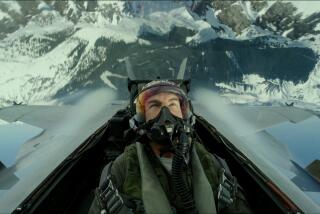Being Fastest With Leastest : Record Seeker Hopes to Achieve 450 M.P.H. in 2,000-Pound Plane
- Share via
PALM SPRINGS — It’s the jet age and has been since the 1950s. Yet pilots and aircraft manufacturers, motivated by challenge, sales potential or publicity, continue to push the outside of the envelope for piston-engine planes.
Howard (Buddy) Foote Jr., 26, an aviator and aeronautical designer who is trying to cut himself an unusual niche in the aircraft industry, is among them.
Flying a carbon-fiber Berkut aircraft, the former soaring champion from Los Alamitos hopes to set a speed record in the months ahead for aircraft of its type. His reasons, aside from personal satisfaction: to help a fledgling aircraft company launch a new design and to promote a potential full-length movie about his life.
“I love breaking records and the process,” said Foote, now of Riverside. “I’ve done it before and I know how to do it. It’s a lot of fun. I also want to help out Berkut. I really like their aircraft.”
The effort is the latest chapter in the Foote saga, which began at Los Alamitos High School when he set several state and national altitude records for glider pilots in his age group. Those records still stand.
Later, as a young aviation mechanic at El Toro Marine Corps Air Station, he flew into notoriety by stealing an A-4 Skyhawk jet fighter in the dead of night and going for a joy ride over the Pacific Ocean. He had had just a few lessons in a flight simulator on the base.
The incident, which was heavily covered by the news media, occurred on July 4, 1986, shortly after Foote’s ambitions to become a Marine aviator were ruined by an air embolism that started during a glider flight. The condition is like the bends, or decompression sickness, that scuba divers suffer.
Now out of uniform, Foote is attracting investors to build the world’s first microwave-powered aircraft, which can stay aloft for long periods at high altitude, making it potentially useful for scientific research and military reconnaissance. Foote designed the unusual aircraft.
In addition, he is negotiating with filmmakers to produce a full-length movie centering on his exploits in the Marine Corps and as a record-setting glider pilot. Dave Bell Productions has prepared a script. The company helped produce the feature film “The Long Walk Home,” a story about the impact of the civil rights movement on a white Southern family and their black maid.
To make ends meet, Foote works at John Wayne Airport and is a test pilot for Experimental Aviation, a small aircraft company based in Santa Monica that makes such innovative airplanes as the Berkut, which means eagle in Russian.
The gleaming white aircraft is 60% carbon fiber, a space-age composite that is extremely lightweight but just as strong as steel, if not stronger. The entire plane, which seats two people, weighs just 2,000 pounds fully loaded.
Designed by Dave Harris Ronneberg, the tailless aircraft has a large wing in back and two small wings or canards mounted on the fuselage near the nose. On the tips of the main wing are two vertical stabilizers or rudders.
Power comes from a rear-mounted, four-cylinder, air-cooled engine that turns a fat, stubby propeller, also made of carbon fiber.
For its small size, the airplane has an astounding rate of climb--more than 2,000 feet a minute. High maneuvering speeds also give it the agility of a fighter jet, something that isn’t found in the average Cessna.
“Nothing in general aviation can hold a stick to this thing,” said Don Murphy, part-owner of Experimental Aviation.
For the record attempt, Foote wants to add a sophisticated turbocharger to the engine that would boost horsepower substantially and push the top speed to roughly 400 to 450 m.p.h.
Foote is determining what the Berkut’s maximum performance is and whether its wings can withstand shock waves generated at high speeds. He anticipates that it will take several months to make the necessary modifications and preparations.
“The big trick is calculating all the structural data to make sure the plane can make it,” he said. “Going out to break a record heavily depends on engineering. What is done on paper is extremely important. You can lose an airplane if it isn’t done right.”
Foote hopes to set a record in a specific classification based on the size of the airplane and its engine.
“People are going after records all the time,” Foote said. “I’ve been doing it for almost 12 years. When I go after one of these things, I’ve been able to do it.”
More to Read
Inside the business of entertainment
The Wide Shot brings you news, analysis and insights on everything from streaming wars to production — and what it all means for the future.
You may occasionally receive promotional content from the Los Angeles Times.










